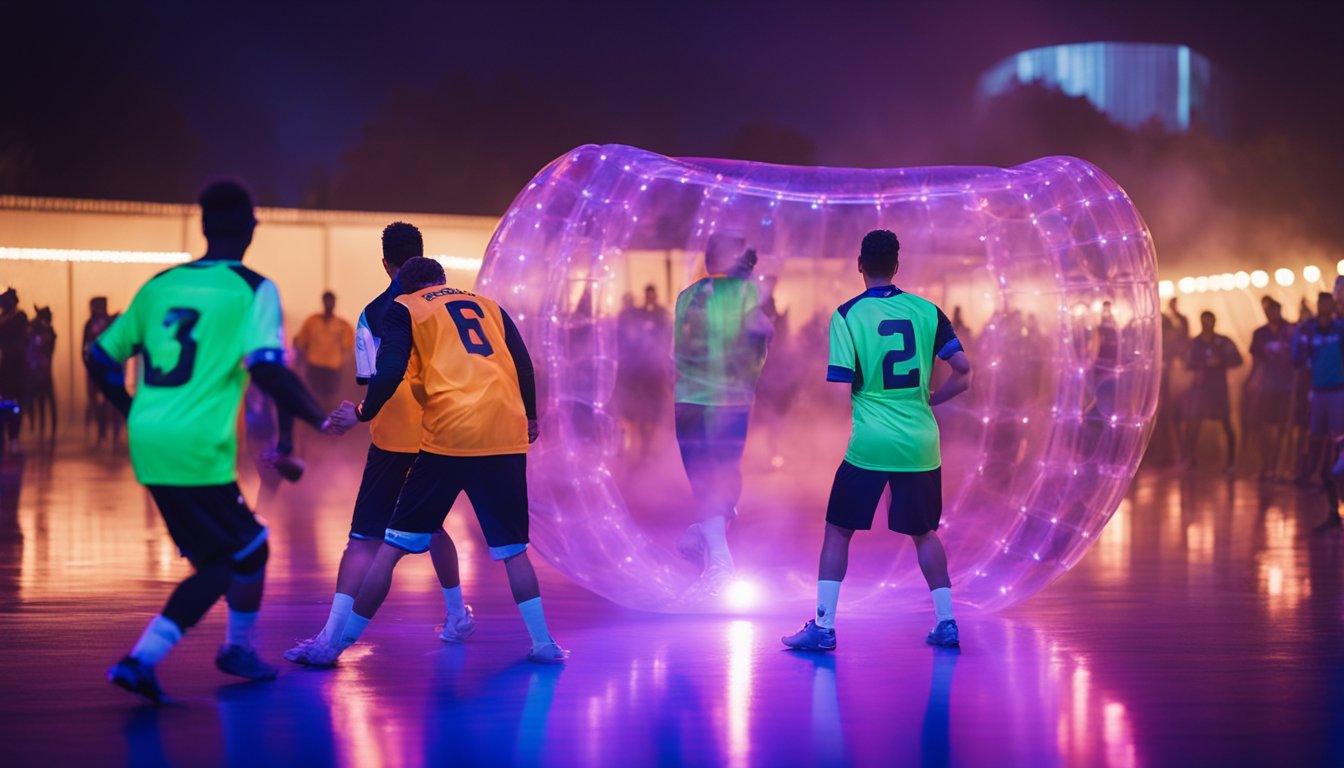Late updated: 05 Oct 2024 11:10
Written by: Emma Saunders
Future Trends In Bubble Football Innovations: Emerging Technologies and Impact
Bubble football is set to undergo a fascinating transformation, driven by technological advancements and innovative thinking in the sports sector. As we explore the future trends in this entertaining game, we find that technology is at the forefront, enhancing not only the gameplay experience but also the strategic elements for both players and enthusiasts. The integration of smart wearables and performance analytics in bubble football is poised to revolutionise how teams approach training and competitions.

Our focus on how technology impacts football, in general, explains some of the trends we expect in bubble football. With the growing interest in immersive experiences, virtual and augmented reality technology could soon bring bubble football enthusiasts even closer to the action, whether they're on the pitch or watching from home. This technological shift not only enriches the engagement but also draws more participants and spectators into this unique sporting activity.
We're excited to see how the governance and regulations of sports adapt to these new innovations. Just as with traditional football, the impact of technology on bubble football means reconsidering rules and ensuring fair play remains integral. As these changes take shape, we anticipate lively discussions on best practices and potential challenges.
Key Takeaways
- Technology is revolutionising bubble football gameplay and strategy.
- Virtual and augmented reality enhance spectator and player experiences.
- Fair play in bubble football adapts with advancing technology.
Technological Innovations in Football

Technological advancements are reshaping football, creating safer environments for players, providing deeper insights into match analysis, and enhancing fan experiences. These innovations are paving the way for a new era of football. Let's explore some key areas of focus.
Advancements in Player Health Monitoring
In recent years, player health monitoring has become an essential aspect of football technology. GPS trackers are now widely used to measure players' movements, speed, and distance covered during matches. This data assists in tailoring training programmes and preventing overexertion.
Heart rate monitors are invaluable in tracking physiological responses to various exercises, ensuring players stay within safe limits.
Sports science, integrated with digital transformation, aids in injury prevention and recovery. Innovations such as these not only prevent injuries but also enhance player performance and longevity. As we continue to embrace technology, the safety and well-being of players remain a priority.
Artificial Intelligence and Match Analysis
Artificial Intelligence has transformed how we analyse football matches. AI-driven ball tracking systems, like Tracab, provide real-time data, offering precise metrics for clubs and coaches. This includes positioning, speed, and even predicting player movements.
The introduction of technologies such as the Video Assistant Referee (VAR) ensures fair play by reviewing and rectifying on-field decisions. These innovations are contributing to more accurate talent scouting, as detailed data analyses highlight player strengths and weaknesses. AI's role in match analysis is a game-changer, bringing a level of insight previously unimaginable.
Enhancing Fan Engagement and Experience
Fan engagement and experience are at the core of modern football. Technology plays a pivotal role in enhancing how fans interact with the game. Through social media platforms, fans are constantly connected to their favourite teams and players. These platforms allow sharing of insights and experiences in real time.
Stadiums have become hubs of digital transformation, with high-speed internet enabling interactive features for fans. This includes AR and VR experiences, providing immersive views of matches. Sponsoring opportunities powered by technology also create personalised content for fans, making each match day unique. As technology evolves, so does the way we enjoy football, keeping us closer to the action than ever before.
The Impact of Football Technology on Competitions and Governance

Technological advancements have reshaped global football competitions and governance, affecting how clubs and leagues, like La Liga and the FIFA World Cup, operate. Innovation drives changes in regulations, influencing strategic planning and training methodologies.
Global Football Landscape and FIFA Regulations
In recent years, technological innovation has influenced how football is played and governed worldwide. FIFA, as the global authority, continually updates regulations to accommodate technological changes. These modifications aim to balance maintaining the sport's integrity while allowing advancements such as robotic assistant referees.
Member associations and domestic leagues like La Liga must adapt to these regulatory shifts. High-profile clubs like Real Madrid often pioneer the integration of technology, setting benchmarks for compliance and innovation. Competitions must also ensure fairness and consistency in applying new technologies, demanding close collaboration between governing bodies such as FIFA and technical directors in the sports industry.
Maintaining universal standards across varied socio-economic environments remains a challenge. Delphi studies and insights from institutes like the Centre for Sports and Management inform the ongoing dialogue on governance. Such dialogue ensures that technological advancements benefit the game globally, maintaining its competitive spirit while adapting to modern needs.
The Role of Technology in Football Strategy and Training
Football clubs increasingly leverage technology to enhance strategy and training. Advanced analytics platforms, such as Zone7, allow teams to refine their tactical understanding, drastically improving their playing style and performance on the field. Real Madrid’s use of technology in training facilities exemplifies this trend.
Innovations like Robogym provide personalised fitness regimes, essential for keeping elite players in peak condition throughout gruelling seasons. Technology also aids technical directors in developing comprehensive strategies, which can influence results in major competitions like the FIFA World Cup. As technology continues to evolve, its integration into strategy and training offers clubs a competitive edge, transforming traditional methodologies to meet modern demands.
Frequently Asked Questions

Emerging trends in bubble football are transforming equipment, technology integration, and player safety. Advancements are also being made in tournament organisation and fan engagement. Material science offers potential for innovative suit designs.
What are the latest advancements in bubble football equipment?
Recent developments focus on enhancing durability and comfort of bubble suits. Manufacturers are creating lighter, more resilient materials that improve player agility. Customisable features, such as adjustable harnesses, are being incorporated. This allows for better fit and increased safety. The goal is to balance protection with the freedom of movement.
How is technology being integrated into bubble football for enhanced gameplay?
Technology integration is changing the way we experience bubble football. Real-time performance tracking is becoming commonplace, helping players to improve their skills. Augmented reality features are being trialled for immersive experiences. Smart bubbles with built-in sensors provide live feedback on impact and positioning, further enhancing strategy and gameplay precision.
In what ways is player safety being improved in bubble football?
Ensuring player safety is a priority. Innovations include shock-absorbent materials and enhanced cushioning within suits. Safety standards are being updated, with rigorous testing protocols in place. Additionally, advancements in suit design aim to reduce risks of collision-related injuries. These improvements aim to maintain the excitement of the game while prioritising player protection.
What are the emerging trends in bubble football tournament organisation?
Tournament organisation is evolving with a focus on accessibility and inclusivity. We are seeing more diverse participation with mixed-gender and all-abilities events. Formats are shifting to shorter, fast-paced matches appealing to a broad audience. Digital platforms facilitate streamlined registration and match scheduling, enhancing the overall organisational efficiency.
How is the fan engagement experience evolving in bubble football?
The fan experience is transforming with innovative use of technology. Interactive viewing options, such as 360-degree live streams, allow fans to feel part of the action. Social media platforms play a key role in engaging fans with real-time updates and interactive content. Enhanced in-app experiences provide exclusive content and behind-the-scenes insights.
What are the potential impacts of material science on the future design of bubble football suits?
Material science advancements hold promise for bubble football suits. We are exploring nanomaterials that offer superior strength while being lightweight. Innovations in breathability could lead to improved comfort during play. Antimicrobial fabrics aim to increase hygiene and lifespan of equipment. These material breakthroughs could redefine our approach to designing the next generation of bubble football suits.
